
Login
X
- Home
- Courses
- Graduation
- Diploma Certificate
- Professional Diploma
- Special sessions / Aptitude boost up
- News & Events
- Student zone
- Placement
- Gallery
- FAQ
- Contact Us
Visual communication that blends words, images, and ideas to convey information to the audience is known as graphic design. Visual communication and communication design are other names for graphic design. Graphic design career produce visual responses to your life.
The websites you browse, the commercials you see, the movies you watch, the games you play, and the packaging and logos of the goods you purchase are all the work of graphic designers. While it’s not always possible to teach someone how to have a good eye for design, most graphic designers have gone to art or design school to advance in their graphic design career.
Publishers, design firms, advertising agencies, and other industries that require skilled designers may also hire graphic designers. The majority of designers are able to complete post-graduate or bachelor’s degree programmes, which aid in their technical skill development and enable them to build portfolios of their work that can help them find jobs more quickly after graduation.
Many businesses, including those in advertising, printing, web design, etc., are in need of graphic designers. Tools like Photoshop, Gimp, Flash, Dreamweaver, Fireworks, Illustrator, Blend, and more should be familiar to new designers. But a designer’s career slows down a little after three to four years of experience. Designing requires more individual creativity than a collaborative effort. Improving your skills would greatly benefit your graphic design career.
The compensation of a designer becomes stagnant at a level of INR 4–5 lacs per year after gaining valuable professional expertise for about 6 years. However, with the development of the internet, there is a significant opportunity for freelance designing for numerous clients even when employed by a single organisation. On websites like Instagram, WordPress, Blogger, etc., you can also design, manage, and run your own campaigns to generate extra income from clicks, likes, and visitors.
In recent years, there have been an unprecedented number of graphic design courses. Graphic designers have a plethora of opportunities in the digital world.
You only need to select the educational programme that best matches your present design abilities and graphic design career growth objectives.
It may be necessary for you to enrol in numerous courses that cover various aspects of graphic design, including principles of graphic design, professional logo design, identity design, publishing design, managing digital design projects, and visual communication.
You can consider enrolling in courses that provide more in-depth instruction in the creative process and its practical application in graphic design once you have a basic understanding of design and have learned certain important design abilities.

Graphic designers are competent in creating logos and can make them. It’s a cursory assessment. Even though a logo is only a graphic design, it has significant marketing and commercial value. Building an effective logo is possible if the graphic designer knows how to accomplish it properly. Here is a step-by-step guide to help graphic designers create a brand logo:
It is critical for designers to research and understands the firm, its aims, and its logo design needs. It is essential to research the company’s target audience so that you can design for them.
Start exploring ideas once you’ve received the basic specifications from the customer and understand what they want in their logo.
The brand does not exist in a vacuum, and there are rivals in the market, and the logo assists clients in distinguishing between different brands. When creating a logo for an organization, take inspiration from their competitors’ logos.
The logo comes in different sizes. Shapes, colors, and variants are available. Because the logo will be the initial thing, people see, ensure you hit the target by selecting the proper type for your company. A logo can be anything from a primary wordmark or letter mark to a complicated graphic. Although there are no hard and fast guidelines for choosing one, you can always explore your logo ideas.
The correct symbol can establish its identity even if a brand does not have a name. There are numerous examples of this (Twitter, Apple, etc.). The human mind responds better to images than text, and Visuals tend to stick with customers longer. Before we read the language in the design, we see the forms. Logos that use unusual, innovative, and one-of-a-kind graphics get more attention from the general population and have become more well-known among the general public.
If you want to develop a logo that has a powerful effect, you must continually experiment with different designs. However, when testing, keep in mind the actual use.
Finally, there are no hard and fast rules or sure-fire methods for creating outstanding logo designs. Ultimately, your individuality and creativity will be weighed, and nothing can compensate for a lack of imagination, a new perspective, and a current outlook.

At Vismayam, we promise that our training technique equips students with the skills they need to be productive in any field. Our instructors make sure that the participants receive industry-relevant inputs and skills to take on more significant responsibilities and thereby contribute to increased productivity and profitability for an organization, whether it be through advanced computer applications, domain-specific training, or soft skills training. As the best multimedia and designing institute, we also make sure learning is interesting, efficient, and fun.

Because we are aware of the demands of the industry, our cutting-edge training technique is created to help you hone your abilities.
We know how to focus your efforts on acquiring the necessary skills so that you can follow your passion and realize your life’s ambitions. Our extracurricular activities set us apart from the competition and make us the best multimedia and designing institute, and guarantee that you reach your objectives.
In order to train candidates in cutting-edge software technologies, our multimedia courses are planned to contain a lot of practical sessions. These programs foster student-industry engagement, help students get ready for job interviews, and prepare them for the workforce.
Both technical and soft skill training is included in the instruction. The candidates will receive professional experience to better prepare them to handle the demanding work demands of the current IT job market.
As the best multimedia and designing institute, Vismayam has always specialized in finding skilled amateurs and developing them into powerful IT specialists.
Accessibility of candidates with the necessary technological and professional skills would surely have a significant impact on the effectiveness of new professionals joining the IT field. In actuality, few organizations provide the necessary instruction that may instantly transform a person into a deployable expert.
The mission of Vismayam is to cultivate young brains into complete professionals who will raise the standard of society around them through invention. Through contacts with academic members, accomplished professionals, fellow students, etc., we encourage our students to uncover their own creativity, design, or craziness. Simply put, Vismayam gives you the courage to create!
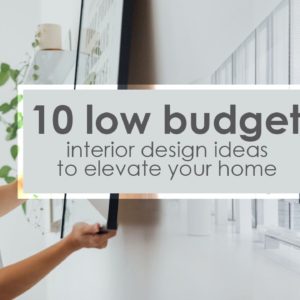
Low budget interior design that creates a well-put-out magazine-worthy home. Most people can’t afford to do the high-end interior décor. There are many ways to enhance and elevate your house in subtle ways without spending too much. Here are some easy and simple ways you can make your home more glamorous without denting your pockets.
Here are 10 low-budget interior design ideas for your home makeover.
Partitioning shelf is a great idea to gain division and privacy creatively. The shelves add additional storage space adding function as well as style the room. Books, vases, potted plants, models can be displayed and stored stylishly. It is a neat and tidy way to organize and display
Buying art can be expensive but art adds colour and beauty to the interior design. A simple and fun way to enhance the living room is doing a DIY art that you can later frame. Use the colours of the living room in the art to tie it all together and bring harmony to the space.
Upcycling furniture is a good way to reuse and reimagine old furniture. Adding funky mismatched-up cycled adds colour and life to space. It is environmentally friendly and budget-friendly. It can be done as an easy family DIY project over the weekend.
Mirrors are versatile and stylish. Adding mirrors to the wall mount is a good cheap way to enhance the interior design. Buying different shapes and sizes of mirrors and arranging them on the wall to give it an elegant stylish look.
Paper lampshades are cheap and convenient to use and buy. There are a lot of beautiful paper lampshades available in the market. The lamps are lightweight and easy to install. It adds attraction and unique touch to space.
Lifting the curtains all the way to the ceiling will give the room an illusion of added height. The high curtains give it a bigger and grandeur look. You can either opt to lift the existing curtain or add new curtains. Curtains are cheap and are readily available and in the market at different price points.
One easy way to remodel your kitchen without burning a hole in your pocket is by switching the colour of the kitchen cabinets. You can paint the cabinet to the colour of your choice and you can also replace the knobs of the cabinets to give it a fresher look. You can also do the same to your bedroom cabinets to change up your old bedroom to a new fresher one.
Under stair, shelves is a great storage idea. The otherwise left-out space can be used by creating a customized shelve space for storage and display. It is both stylish and functional.
Don’t be shy and add a bold coloured wall to your interior design. The bold coloured wall can be used as a backdrop and add accessories to the room that match the wall colour. You can also add texture or pattern to the wall. This can be either a DIY project or you can consult a professional for it.
Candles and flowers bring freshness and beauty to space. It can be arranged almost anywhere in the house. You can arrange flowers in the bathroom to give a fresh and expensive spa-like feel to it. It will also give a pleasant smell enhancing the whole experience.
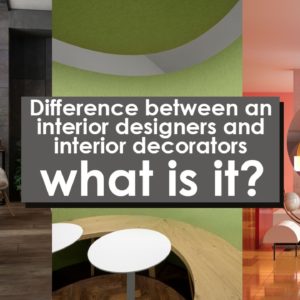
The difference between an interior designer and an interior decorator is not well known. Even though there are similarities between them, they are different careers. People often mistake interior decorators and interior designers. Here are some similarities and differences between interior designers and interior decorators.
Interior designers are mostly professionals with a degree or diploma in interior designing. There are different ways one can become an interior designer. Interior designers should how the architecture and the built of the space. They use a mixture of science and art to create a perfect interior design. They work alongside the architects to create functional and beautiful living spaces. The experts in the field of interior design must have a firm grasp on building construction. They strive to create optimal functioning spaces with cost-effective methods.
Interior decorators mainly focus on enhancing the aesthetics of the living space. As the word ‘decorate’ indicates they nicely decorate the given space. They may redo or rearrange the wallpapers, paint color, and furniture of the interior. Interior decorators do not have to hold any relevant degree. They are mostly people with good artistic creativity and a knack for décor. They work within the framework of the space and its functionality. To change the aesthetics of the space they make use of fabric, paint, furnishing, and accessories.
Both of them are hired by the owner, architect, or developer. Before they begin, interior designers meet with the client to understand how space will be utilized. Interior designers while creating a plan focus on things like building fire safety, accessibility, efficiency, and functionality. They also keep sound and acoustics in mind. Creating the plan for the walls and floors requires architectural base knowledge. They make use of science to create optimal results. The total budget is estimated during the planning phase
On the other hand interior decorators while planning and designing keep in mind only things of aesthetic value like flooring, furnishing, lighting, fixtures, accessories, fabric, paint, and art. Interior designers work on both commercial and residential levels while decorators largely work on the residential level.
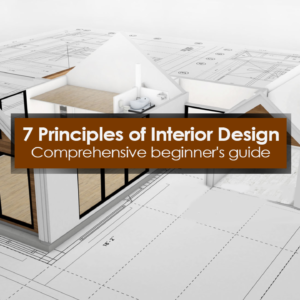
7 principles of interior design are widely accepted by everyone in the industry. It is tried and true recipe to create interior spaces that are functional and aesthetically pleasing at the same time. Like the golden ratio in architecture the 7 principles also enhance and elevate the interior design.
Let’s dive deeper and get to know all seven principles of interior design.
The first thing to keep in mind is balance. What is balance in terms of interior designing? It is referred to as “visual weight” distribution. “Visual weight” refers to how heavy or how light an object appears to the human eye. Large, solid, dark, or colorful seems heavier to the eye than small, thin, open, or light objects seem lighter to the eye.
A good way to ensure that the visual weight distribution is good is by dividing the space into 4 quadrants and each quadrant should contain roughly the same amount of furnishing.
Like the music, repetition helps in visual appeal too. Just as creating musical patterns creating a visual pattern is necessary for interior designing. It creates a space that is cohesive and gives a seamless moment to the eye to flow around the room. The element for repetition can be anything from texture, shape, pattern to finished materials.
Try to create a focal point. It can be something inbuilt like a fireplace or something that is deliberately placed in a way like a piece of art or furniture. Lay the design around the focal point such that it is the first thing someone will notice when entering the room.
To make sure the interior is not boring contrast and variety, to say the least, is a must. Additionally, contrast gives the space drama and variety adds diversity and personality. You can achieve it by pairing contrasting colors, shapes, and textures
Scale and proportion will ensure that objects in the room belong and relate to each other. Proportion refers to the size of one object concerning another while Scale refers to the size of objects within a space.
Unity and harmony ensure that everything goes with everything else in the room. It is achieved when the design and furniture follow the theme. Decorating accordingly with items that have common colors, patterns, shape, or style will help to achieve unity and harmony

Interior design course details on frequently asked questions are given below. Please refer to the below questions. for more details contact us at 0495 2722242
BSc interior designing is a three-year course that equips aspiring interior designers with the necessary skills needed for it. In the three years of the course, several core topics about Interior designing are addressed, practical’s an internship. Interior designing is not just artistic talent, the process of interior designing involves scientific, logical, and creative thinking.
Communication Skills
Basics of Interior Design
Environmental Studies
Cost Estimation
Construction Technology
Materials and Finishes
Colour Theory and Techniques
Design Theory
Materials and Finishes
Colour Theory and Techniques
Design Theory
Material Purchase
Furniture Design
Model Making
Design Technology
Drawing (Technical)
Design Practice
There are a variety of different job opportunities here is a list of few
Product Designer
Furniture Designer
User Experience Designer
Interior Designer
Set Designer
Interior Elements Advisor
Interior Space Consultant
Model Maker
Portfolio Designer
Blogger
Interior Decorators
Bathroom Designers
Universal Designers
Sustainable Designers
Industrial Designers
Professor of Interior Design
Exhibition Designer
Kitchen Designer
Healthcare Designer
Corporate Designer
Lighting Designer
Architectural Technologist
Production Designer.
BSc Interior design (by Barathiyar University)
Interior designing is a multi-faceted profession which includes numerous element that needs to work together.
First and foremost is research and analysis of the client’s goals. Sit with the client to understand their wants and needs also their likes and dislikes. Form schemas and plans with the help of two and three-dimensional design concepts that integrate knowledge, creativity, principles of interior design, and client needs. Then comes the selection process which includes finding furniture, fixtures, and equipment. Creating layout drawing, detailed product description, provision of contract documentation to facilitate pricing, procurement, and installation of furniture. Preparation of construction documents, consisting of plans, elevations, materials and finishes details and specifications, power and communications locations; reflected ceiling plans and lighting designs; and furniture layout. Collaborating and coordinating with various allied professions for plumping, electrical wiring, etc. Observing and reporting while the project is in progress till completion.

Multimedia and its applications are vast and varying . There are a plethora of definitions of the word multimedia. It is roughly defined as a computer-controlled integration of text, audio, video, animation, and any other media that is stored digitally, signified, and transmitted. Multimedia and its application are an integral part of day-to-day modern life.
Multimedia can be both linear and nonlinear. The direct active context that requires no navigation or interaction control is linear multimedia. Movies are a good example of linear multimedia. Non-linear content is also known as hypermedia content uses interactive navigation control. Games use non-linear content to provide user interface and navigation.
for multimedia and its applications different elements play a vital role.
The most basic and well-known form of multimedia is text. It is the foundation for word processing programs, it is still the fundamental form of information used widely in multimedia programs. Text can be customized according to size, font, and color. It is one type of application people use every day to communicate.
Audio is an effective multimedia application. Select types of information can only be conveyed only through sound. Audio sound helps strengthen the viewer’s consideration of the information and helps generate a positive impact more than any other medium of multimedia. The versatile nature helps capture the user’s attention and makes it more interesting.
An image is worth a thousand words’ true to this proverb still graphic image conveys the information across efficiently. images enhance the multimedia appeal.
Animation is essentially moving graphics images. An animation of someone performing a medical surgery is much easier to understand than text or images. Animations make it easier for the creator to express the information.
Full motion video adds to the multimedia application positively. Even though, the full-motion video is space consuming and lowering the video quality will affect the impact it creates. it is a very popular method of multimedia. It provides realism to the multimedia that most other elements can’t provide. There are several ways to compress the videos to reduce the bulk and storage space.
It provides a wide range of creative applications for information communication.
It caters to all types of people.
Most multimedia only require a one-time purchase of a device making it cost-effective in the long run.
It provides a more realistic approach to learning
Current culture integrates multimedia in all areas of life. Making it the most trending form of communication.
The deceives need electricity to operate. Most rural areas lack the basic requirement necessary for multimedia propagation.
It may take away from the important information due to its attention-grabbing nature.
Compared to traditional mediums of information multimedia production is costly.
Creating multimedia requires more time because of its creative nature.
Multimedia mastery requires a significant amount of time and energy because it is complex and involves a number of elements
Multimedia is vulnerable because the devices involved can be easily broken or tarnished. Additionally, most devices are not waterproof making them fragile. Some damages are repairable while others are not adding to global pollution.
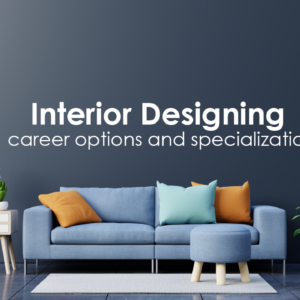
Interior designing career options seem to be not many but, it is not true. In India, there is a demand for more than 1 lakh interior designers in different for different specialization. The common misconception that interior designing as a career only entails the job of designing living spaces.
There are numerous interior designing career options for interior designing graduates. Below is a list of fun and creative job titles after graduation.
If you have a strong inclination towards tasteful furniture that enhances the commercial or personal living spaces this is the job for you! Your job is to create modern furniture that is both stylish and functional.
Most of the world is not aware of this job title. In fact, it is one of many jobs that are not well known to the public. The job is to create temporary fixtures and display stand for art galleries, museums, large public exhibitions, conferences, trade show, and businesses.
Demand for a stylish, personalized, and functional kitchen for commercial and personal spaces. Hence, the job entitles creating, updating, and remodeling the kitchen area. You will have to regularly meet with the clients to discuss building materials, themes, room layout, colors, and patterns and embody their dreams into reality.
This is one of the fanciest and high fame job titles. Production designers are responsible for the visual concepts of television, theatre or film sets. They are in charge of creating a set with props, location, and graphics, lighting, costume, and camera angle therefore, the job is a very demanding high reward type of career. Also, every set and production is unique and each location/scene has its challenges.
The job is to provide building designing service, train in architectural technology and builds technical design and construction. They work alongside architects to produce compelling unique commercial spaces.
Tricky but well rewarding job. Universal designs are designs that take into consideration of people with a wide range of difficulties and accommodate all people. Universal designs can help people with disabilities to access and utilize public spaces that would otherwise be difficult to use.
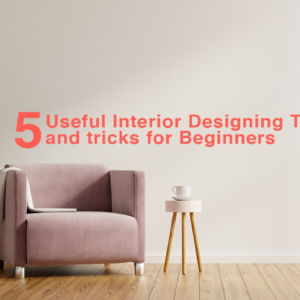
These interior designing tips and tricks can help you redesign your living space. Here are some interior designing tips that will guide you to accomplish that. A well-made interior design is a statement. It reflects your personal style and taste. As an amateur decorating, furnishing, lighting, and accessorizing may seem hard and confusing. But if you have a good imagination and a style on your mind the task can be accomplished with the help of these tips
If you are someone with a zest for redecorating and designing interior spaces consider taking up interior designing as a career. There are many degrees, diplomas, and certification courses available. Interior designing as a career offers a wide variety of jobs.
Some of the major interior designing tips to keep in mind are
Before trying to redo your living space make sure to pick a style and stick to it. To make the interior more appealing stick to a style and make sure you fit your furniture, accessories, art, wallpaper, lighting, etc fit with the theme.
Lighting is quintessential to any space. One way to make sure the room has good lighting is by observing how natural sunlight falls in the place. If there are places where there is no or weak natural lighting consider placing lights there. Go with lighting that fits your preferred interior style.
One tip is not to purchase furniture that comes in a set. A little bit of variation will add more soul to space. Don’t overspend on the furniture that will leave you with little money for the rest of the things.
In small spaces go bold in colour and style in terms of the wall colour. Make sure not to pick paint before you settle on a style. Only choose a colour when the theme is finalized.
A good way to elevate the floor without redoing the entire floor is by adding rugs and carpets that bring life by adding colour, texture, and warmth to the place. Keep in mind to add cheap and durable rugs in high use/traffic common areas and luxuries more expensive carpets/ rugs
These might seem like unnecessary spending but, trust us accent piece and accessories goes a long way. For example, if you are a big beach fan incorporate elements from it like seashells in a jar for display.
If done right it can add a personal touch without being overwhelming. It ties everything together creating harmony among different elements.
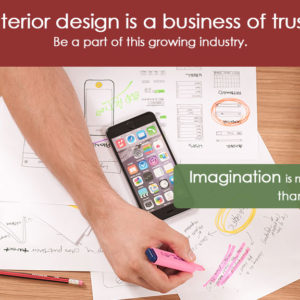
BSc Interior Designing syllabus and eligibility vary across various universities but the core subject and minimum eligibility are almost homogeneous across all universities. After completing 12th-grade students are often confused when choosing a career path. Questions like which stream to pick, which careers will be optimal plague their minds. If you are artistically gifted and have a keen eye to furnish and create aesthetically pleasing environments you might have already thought of interior designing as a career path. given below are the detailed BSc Interior designing syllabus and eligibility of Bharathiar University.
Minimum eligibility for BSc Interior designing is 12th graduation. also, lateral entry to second-year is possible for students who completed a one-year diploma in interior design.
The university follows yearly examination as opposed to semester-wise that most other university structure and courses.
FIRST YEAR
|
Year |
Part |
Subject and paper |
University Exam. | |||
| Duration in Hours | Max. Marks | |||||
|
First |
I | Language | Paper 1 | Language-I (Optional language) | 3 | 100 |
| II | English | Paper 1 | English (Communication skills) | 3 | 100 | |
|
III |
Core |
Practical 1 | Interior Design – I | 3 | 100 | |
| Practical 2 | Interior Graphics – I | 3 | 100 | |||
| Theory 1 | Materials of Interiors – I | 3 | 75 | |||
| Practical 3 | Presentation Technique | 3 | 75 | |||
| 3 Theory and 3 Practical | Total Marks | 550 | ||||
SCHEME OF EXAMINATIONS
|
Year |
Part |
Subject and paper |
University Exam. | |||
| Duration in Hours | Max. Marks | |||||
|
second |
III |
core |
Practical 4 | Interior Design – II | 3 | 100 |
| Practical 5 | Interior Graphics – II | 3 | 100 | |||
| Practical 6 | Furniture Design | 3 | 100 | |||
| Theory 2 | Materials of Interiors – II | 3 | 75 | |||
| Practical 7 | Computer Application in Design – I | 3 | 100 | |||
| Theory 3 | Estimation and Costing in Interiors | 3 | 75 | |||
| 2 Theory and 4 Practical | Total Marks | 550 | ||||
SCHEME OF EXAMINATIONS
|
Year |
Part |
Subject and paper |
University Exam. | |||
| Duration in Hours | Max. Marks | |||||
|
third |
III |
core |
100 | Interior Design – III | 3 | 100 |
| 75 | Landscape and Environmental
Design |
3 | 100 | |||
| 75 | Professional Practice and
Management |
3 | 100 | |||
| 100 | Scheme Detailing (Working
Drawing) |
3 | 75 | |||
| 100 | Computer Application in Design – II | 3 | 100 | |||
| 150 | Office Training (Internship) | 3 | 75 | |||
| 2 Theory, 3 Practical,
1 Project |
Total Marks | 600 | ||||
The three-year BSc interior designing focus on various core aspects of interior designing. There are several job opportunities waiting for students who graduate. The rise in urbanization and population made sustainable interior spaces in high demand.
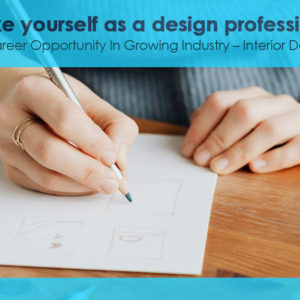
Best interior designing colleges can be hard to choose, researching and gathering details about them need great precision. For some of us creating an aesthetic landscape is a passion but, passion alone can’t make a career. To transform a passion into a profession needs a great deal of planning also a great deal of creativity.
Interior designing is an artistic job. There should be a streak of imagination to transform empty spaces and bland walls into tasteful lively spaces. Here are 3 things to keep in mind while choosing the best interior design college to kick start your career in the industry.
One of the criteria that all the best interior design colleges have in common is reputation also these colleges are often competitive in terms of admission. A college with a good reputation will do wonders for your career. Make sure to choose an option with strong alumni who went on to be successful. There are many colleges with a good reputation but don’t let it fool you, be specific and confirm that the college has a good reputation for the interior designing department.
How relevant is the course offered? Make sure to do your research thoroughly. A few ways to narrow your options are to choose a college that provides an updated syllabus for learning. Make sure the software used is relevant in the real-world working environment.
How valuable your is degree certificate? There are hundreds of degrees and diplomas available to pursue for varying durations of time with different syllabus and projects. Ensure that major companies in the industry accept and recognizes the degree college provides.
Vismayam College of arts and media is one of the best interior designing colleges in Calicut it is the result of reputation that is stemmed from more than a decade of successful output. Get a detailed syllabus and course structure to make your rightful choice.
Suggested readings for you..

If you have a creative side, then you can actually explore your potential. Even though art has many forms, making a career out of one is equally exciting! And with Interior Design, it only gets better. But, how do you decide the best interior design college for you?
Don’t worry, this blog takes you through a few points that you may look up before zeroing down to a college of your choice.
When it comes to making a checklist about picking a college of your choice, it absolutely makes sense to consider many factors individually and together. One particular college may be average in one aspect but strong in another. So, after considering everything, go for the one that suits you the best.
Here are a few pointers that will help you with shortlisting a good interior design college.
When you wish to study a subject of your choice, it is only natural that you get guidance from someone who masters it. Before you join a college, it makes sense to know the feedback and quality of the teaching faculty. An interior design college makes sure to enrol productive people on board. And their quality speaks in terms of students’ feedbacks and years of experience in teaching.
After all, teaching is not everybody’s forte!
Take any educational institute. For all its programs, the institute should fulfil certain official requirements that meet course standards and make students eligible for placements. If it is a degree program, the interior design college should affiliate it with a recognized university.
However, in the case of Diploma courses, a college may or may not affiliate itself to a university. Rather, many established and leading colleges run their own Diploma courses. After all, they have years of expertise to back these.
These are some very important aspects of any creative course- seminars, workshops and similar activities. For any interior design college, these activities form the very offerings for the professional grooming of students. When we talk of activities, we are talking about involving students in all possible art episodes around the institute, say an arts fest or a creative meet.
With workshops, the college demonstrates the importance of learning by doing. And seminars/presentations open up a lot of opportunities for the students. More so, when you have industry stalwarts engaging in meaningful activities and conversations with students.
Since interior design is a professional course, many interior design colleges tend to have a tie-up with architecture and design firms for their graduates/diploma- holders. Now the important point to consider here is- the placement record of students.
Instead of mere tie-ups, a good interior design college has a good placement record. In fact, the placement cells of such colleges start training their outgoing batches through various sessions and workshops, for a quality career launch.
After all, a career support right when you graduate gives you a sense of direction and a path to continue on to.
Interior designers know the value of teamwork. Be it on the site, over the drafting table or in the office, teamwork makes or breaks a project. Here, you not only need to have the knowledge, but also professional and time management skills. While your portfolio may be excellent, it will not cover up for your lack of interview skills. Even if you can converse fluently, you cannot substitute drafting skills with it.
And that is why it is important to keep a track of what all your favourite college offers in terms of real-life skills. There are many finer details that make a big picture perfect. But without those details, the same picture may turn out to be a less- than- a mediocre piece of art. And the same concept applies to your career also. No matter how much you learn, without the right ways of expressions and skills, all these may fall flat.
A good interior design college can be the very factor that may add great value to your career. Hence, whenever you choose, choose it wisely.

Interior Designer as a career is quite recent, but the job? Well, people have been practicing it since centuries! While the basic concept was quite vague, knowingly or unknowingly, it found a way into spaces. And that’s how we know the profession as it is today.
However, where does an interior designer fit in the grand scheme of things?
In fact, it is this point that can give answer to many questions in design project. So, let us go through the tasks of an interior designer, one by one.
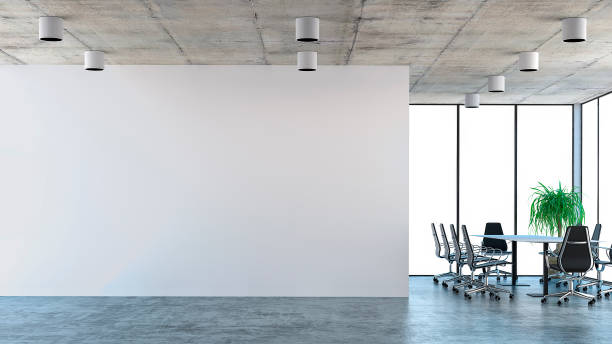
Yes, we need people to design our spaces. Be it your house or your office, any space has its own set of requirements. While the function of a space is important, however, there are many other factors as well. Age of the user, time of usage, climate, safety considerations, building services etc are other crucial points for an optimum space.
That is why you need to consult an interior designer. Somebody who is fluent with all of the above, even the technical aspects.
Additionally, with a designer, you also have the advantage of expressing your concerns and finding solutions.

These days, nothing is cheap, not even designing and construction. But, even though you pay designing fees, you end up saving a lot, lot more when you avoid bad designing.
So, what do we mean by bad designing? For example, poor furniture design that leads to chronic fatigue. Or, poor planning of ventilation and lighting- that worsens eyesight and respiratory health, etc.
And with a designer, not only do you save money on corrective measures with bad designing, but also on the resulting medical bills!

Not only does an interior designer know what to do, but she also knows how to do it. Instead of random construction processes, Interior designers follow the most suitable professional way to go about a project.
Well, they literally learn something called DESIGN PROCESS in their design curriculum. Not only does that help the designer to plan better, but it also makes the whole designing episode a lot more stress-free. As a result, the work flow is smooth, there are answerable people around and your stress level is almost nil!
With interior design projects, regulations come into play right from the conceptual stage. So, there is this chain of tasks that the designer follows to regulate each part of your project.
Now, that is one good benefit of having an interior designer around!
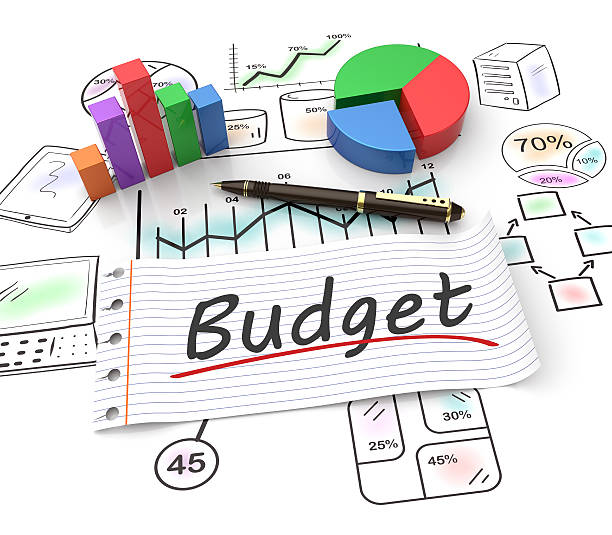
When you plan a structure, you also plan its budget. And even though it is easy on paper, but when it comes to real site- time, things often go out of hands!
And that is where an interior designer works her charm. Instead of straying away, she ,manages each penny, tallies all expenses and quite often, bags you the best deals!
How? Well, regular projects means regular material demand and supply. And that means business with a regular bunch of traders, which often translates to better prices. Isn’t that one amazing add- on?!

If you skip supervision, then literally, you destroy an interior! And since interior designers understand its importance, they never compromise over it.
Even though the papers may describe everything perfectly, still, you may often come across poor quality of workers or workmanship. And it is here that the designer saves your day! There are many things that can go absolutely wrong in a site. And the designer makes sure nothing goes against your plans.
Be it material inventory, labor issue, temporary setbacks or delays, an interior designer takes care of each and everything. They explain, correct, rectify and even repair, if that need arises.

Here we are not talking about aesthetics. That is obviously on the list. But with interior designers, you often get that something more out of them for your space.
Yes, designers love challenges and they love providing solutions all the more. So For some, they may come up with a multipurpose furniture. For others, it may be clever lighting. Yet others may be renovating their furniture.
Utility areas, landscaping, soft furnishings… basically, it could be anything that you can modify and enhance its value. Ultimately, what it does is, adding oodles to the space quality.
Basically, interior designer is the link between a structure and its user. With knowledge and experience, an interior designer works up perfection!
Phone: 0495 272 2242